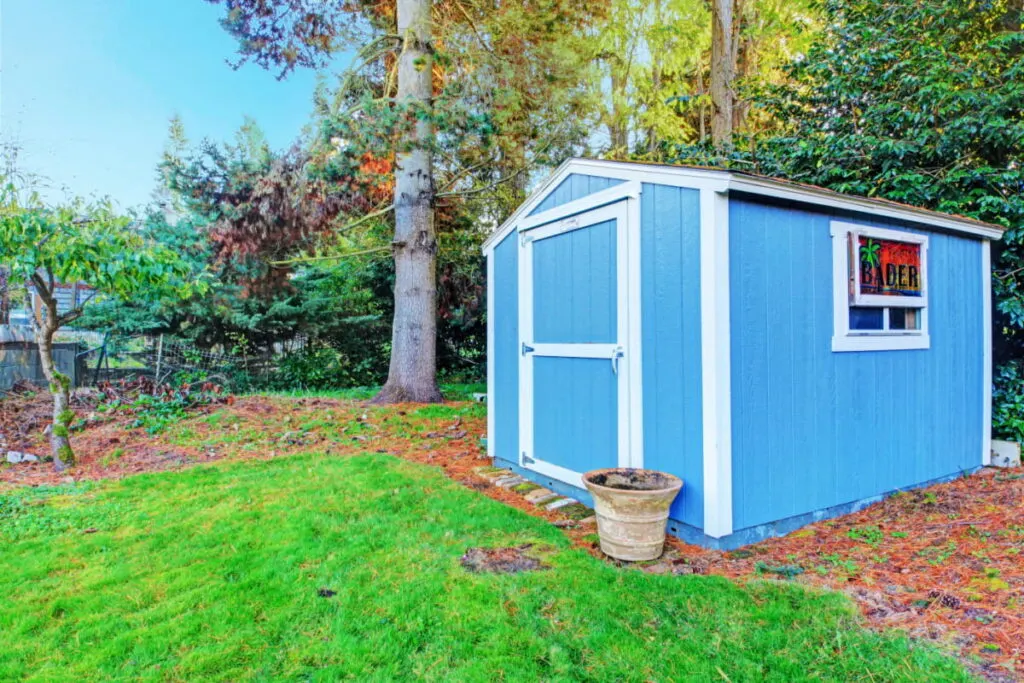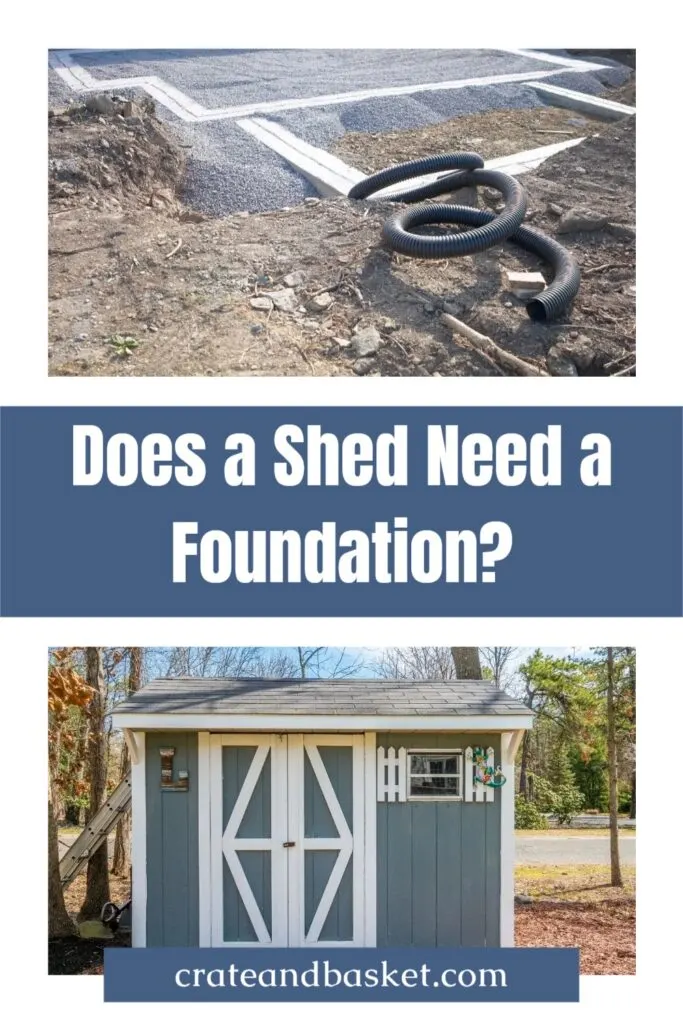Have you decided to add an outbuilding to your property?
There are so many reasons you may want to build a backyard shed. Regardless of your particular reason, you must put up a solid structure.
Does a shed need a foundation?
While small sheds that measure 6×8 feet or less are known not to require a foundation, they will benefit from having one. Having a solid base will generally ensure that a shed lasts for a long time regardless of its size.

When determining the quality of a new structure, you must consider the importance of a foundation.
In this article, we’ll discuss the benefits of constructing a solid foundation, how to know when and where to use a foundation, and the materials to use for a reliable foundation.
Table of Contents
Does a Shed Need a Foundation?
While you might be able to use a small shed without foundation for a while, it will not last long.
Just like building a house or any structure, a foundation is crucial when constructing a shed.
Without a good one, irrespective of how great the shed’s build is, it may not last for very long.
Foundations serve as anchors that ensure that any building, including a sheds, remains erect for a very long time.
Just how essential a foundation is can be dictated by the shed size, construction, and placement.
Intended Use
Without a doubt, how you plan to use a shed has a significant impact on the foundation.
The function of the shed will also determine whether or not a foundation is necessary.
For instance, a garden shed may not require a foundation. You can safely choose for such a shed to have the same kind of base the garden possesses.

Existing Structures
Some sheds are constructed on existing all-round concrete flooring on the land. In these instances, it might be unnecessary to build a foundation for your shed.
Unless you have a specific need for a different type of foundation, your shed will do just fine on a general subfloor.
You may also deem a change necessary if the foundation of the space is old and worn out.
Natural Terrain
Except for an already prepared ground, no section of earth is completely level .
A foundation evens the ground, leaving no room for problems like instability. An excellent base will also provide all the support your shed needs.

Construction Material
The materials used will go a long way in dictating whether you should use a foundation for your shed.
Without a substructure, the moisture from the ground quickly rots wood and rusts metal. Not only will this damage the shed but also open up the contents to damage from the elements.
Popular Types of Sheds
A shed is not just a box to store things or a garden. The use of a shed may vary from a storage unit to a relaxing spot. Here are the most popular types of sheds.
Garden Shed
People keep gardens for different reasons, but anyone who owns a garden often easily considers having a shed nearby.
A shed can provide a temporary resting and clean up place after gardening before returning to the house.
Having a shed close to where you work can make tools and supplies more easily accessible.
She Shed
A she shed is a separate space where any woman can escape to have time to herself with little or no distractions.
This creates an atmosphere away from her home, family, husband, and children, if applicable, to recharge and be herself.

She sheds serve different purposes depending on the individual. Common reasons are to own a cozy place to relax, read a book, listen to favorite music, or develop a new skill.
They are also used for enjoying time with friends or creating a space to enhance creativity.
Office Shed
Why have your office far away from home when you can have it few steps away? You may construct an office shed to bridge the gap between work and home.
With this, you are not directly working from home. You are only working from your office, which is a shed on your property.
Office sheds are constructed to include all the owner would need to work effectively. They are appropriate workplaces to make money and do productive work.
One of the upsides of getting an office shed instead of a proper office or studio is that it saves you the cost of acquiring new space.
It equally saves you the daily cost of commuting from home to work and back.
Tack Shed
Horse stables are often built to keep horses safe and sound. However, the storage of all other horse materials and equipment is not usually considered.
This is where tack shed comes into the picture. It is a beautiful addition to horse stables to store horse riding items like stirrups, saddles, bridles, and other equipment.
A tack shed is even more valuable to people who own large amounts of horse equipment. This often happens with people who conduct or participate in horse riding competitions.
When planning to construct a tack shed, it is essential to take the number of horses owned or intended to be owned into consideration.
This will determine the size of the tack shed. The location of the horse stable also determines the location of the tack shed.
Tiny Home Shed

A tiny home shed is a home built within the confines of a shed structure. It is a shed that serves as a place to live for the owners.
This home is called tiny because of the singular fact that it is a shed with limited home space.
There are several advantages of buying or building a tiny home shed over renting or purchasing an apartment.
Tiny homes tend to be cheaper especially when compared to an apartment. They are also easier to access and takes less time to complete.
Tuck Shop Shed
A tuck shop shed is a kind of shed constructed to serve as a shop or mini-mart. This shed serves as a way for the owners to pursue a small business.
These are used to sell whatever the owner wishes to sell. This may be farm produce harvested from the garden, food cooked in the house, fresh flowers, or even daily consumables.
Shed Foundation Types
Just like sheds differ based on their functions, the shed foundation varies based on the materials used to construct it.
Concrete Foundation
This is one of the most common kinds of foundation when constructing a shed.
A concrete foundation, which may be simple or include reinforcements, is usually square or rectangular.
This foundation, otherwise called a raft, is expected to create a leveled ground using concrete of similar size, shape, and texture.
The dimension of the shed usually determines the number of square or rectangular concrete blocks to use.
A sloped ground may, however, require extra material to achieve the intended level of concrete foundation.
Thankfully, good foundation blocks often solve the problem leaving little or no need for more resources.
This type of foundation is easy to install. All that is needed is concrete blocks stacked and arranged in a leveled format.
It is equally suitable for any shed, whether big, small, tiny home, garden shed, or tack shed.
Some of the disadvantages of concrete foundations include their tendency to sink over time due to moisture from the natural water flow. Also, it is not suitable for ground with slopes higher than 24 feet.
A concrete slab is still considered one of the best kinds of foundation because it is strong enough to allow motor vehicles without breaking. Thus, it is often used for more permanent sheds.

Gravel Foundation
Although this is an easy one to adopt, it is not straightforward enough for a novice to undertake.
It is suitable for sheds of any size, shape, and function. It is equally a good fit for sheds with a ready-made ground.
This type of foundation is constructed using gravel pads, which are usually in small pieces. They are arranged on the floor and leveled to the desire of the owner.
You may use several layers of the gravel pads, padding each layer successively on the leveled ground. This formation is to increase the life span of the foundation and provide a very thick base.
However, a gravel foundation, depending on the floor, may need drainage. If this is not provided, the foundation risks sinking into the ground.
Dirt Foundation
Just as the name implies, a dirt foundation is one created out of dirt or soil.
Soil is one of the materials that can be effectively utilized to create a good base in constructing a shed.
When using soil, you have the opportunity to make the foundation either shallow or deep.
Shallow foundations usually entail spreading, layering, and leveling the earth.
A deep foundation entails doubling this process twice or more with several layers of soil on the ground.
Other kinds of foundations include wooden foundations, plastic foundations, and metal shed foundations.
Final Take
Generally, sheds need a foundation to ensure longevity. But you may find very few situations where your shed may do without one.
All in all, you should construct your shed with a foundation. There are more benefits to having a foundation than to not having one.
Resources
- https://plasticinehouse.com/popular-shed-foundations/
- https://www.sheds.co.uk/blog/why-do-i-need-a-base-for-my-shed/
- https://www.housebeautiful.com/room-decorating/outdoor-ideas/g2614/she-sheds-ideas/
- https://www.countryliving.com/gardening/garden-ideas/a35458/how-to-make-your-own-she-shed/
- https://www.gorillasheds.co.uk/tuck-shop-sheds/
- https://www.abcsheds.net.au/blog/adding-a-tack-shed-to-a-horse-stable
- https://www.thetinyhouse.net/tiny-house-shed/
- https://www.bobvila.com/articles/building-a-shed-foundation/
- https://www.shedsandthings.co.uk/what-sort-of-foundations-are-needed-for-my-garden-shed-36-w.asp
